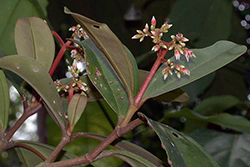e-Flora of Thailand
Volume 7 > Part 3 > Year 2001 > Page 463 > Melastomataceae > Pachycentria
1. Pachycentria constricta (Blume) Blumewfo-0000161405
Flora 14: 519. 1831; Bakh.f., Rec. Trav. Bot. Néerl. 40: 124. 1943; J.F.Maxwell, Gard. Bull. (Singapore) 31: 202. 1978.— Melastoma constrictum Blume, Bijdr. Fl. Ned. Ind. 17: 1049. 1826.
Accepted Name : This is currently accepted.
Synonyms & Citations :
Description : Epiphytic or rarely epilithic shrubs, to 1.5 m high, adventitious roots with tuberous, orange to brown swellings, young branchlets flattened, grooved or with two ridges, becoming terete and smooth, covered with a red-brown indumentum or glabrous. Leaves 5.5–24 x 2–8.5 cm, lanceolate to elliptic or obovate, base narrowed, rounded, or cordate, apex obtuse or acuminate, lamina with 1 pair of lateral primary veins, midrib prominent, secondary venation obscure, subcoriaceous, often purplish below, petioles 0.3–1.5 cm long. Inflorescences many-flowered terminal paniculate cymes, often with bright red axes, 2–6 cm long, peduncle 1–3 cm long, bracts and bracteoles minute, triangular and persistent. Flowers 4-merous, 5-10 mm long. Hypanthium urceolate, 3–4 x ca 2 mm, calyx rim truncate with 4 thickened cusps, sparsely furfuraceous, pink, ovary ⅓ as long as the hypanthium, completely adnate to the hypanthium, stamen pockets lacking. Petals oblong or obovate, acuminate and thickened at the tip, clawed at the base, 5–7 mm long, white to pink, often tinged pink, sometimes yellow, glabrous. Stamens 8, isomorphic, 5–6 mm long, anthers cylindrical, curved at the tip, connective with a 0.5–0.75 mm long dorsal spur arising from the lower half. Berry 5–7 mm in diam., capped by the red calyx remnant, urceolate when young, later globose, immature yellowish-green, mature orange to dark red.
Thailand : PENINSULAR: Chumphon, Ranong, Surat Thani, Phangnga, Phuket, Krabi, Yala.
Distribution : Burma, Malay Peninsula, Sumatra, Java (types of Pachycentria constricta, P. junghuhniana, P. zollingeriana and P. javanensis), Borneo (types of P. macrorhiza, P. oligosperma and P. lanceolata), Celebes, the Philippines (type of P. formicaria).
Ecology : Pachycentria constricta is found in a great variety of habitats, from dry to wet forests and from nutrient-poor to nutrient-rich sites, it occurs at up to 1,300 m alt. The seeds of P. constricta are dispersed by ants, and the species can be found growing on ant plants or in ant gardens. The adventitious roots often are swollen orange tubers that store water (Clausing, Flora 193: 361-368. 1998).
Notes: Young leaves are purple below; in older leaves, at least the main nerves are flushed red. The inflorescences and peduncles are orange to red. The petals may be red or white, or red with white margins or white tinged pink or white with a pink base. The anthers are mostly pink or purple with a white, rostrate tip, and the style is white with a pink stigma.

